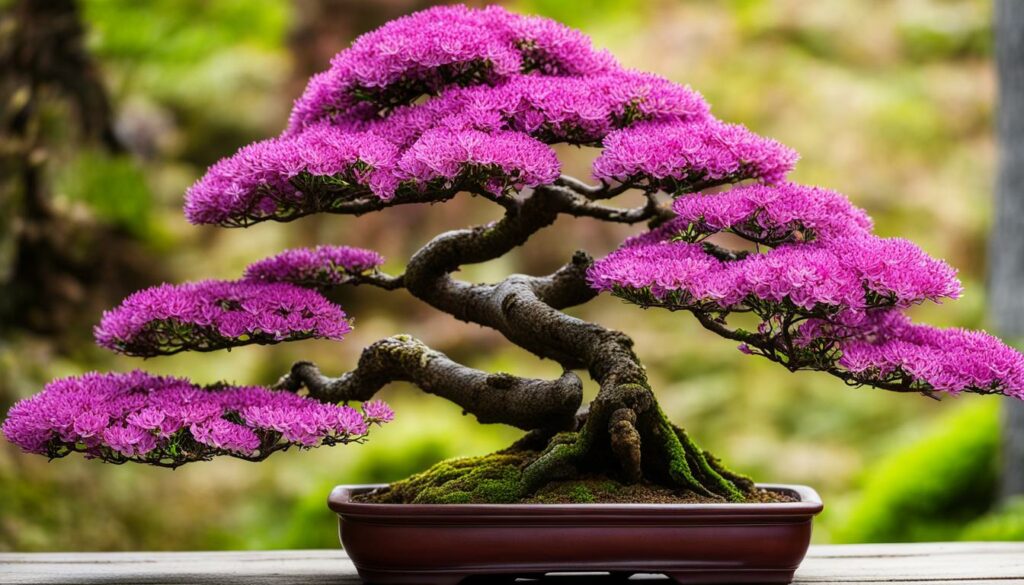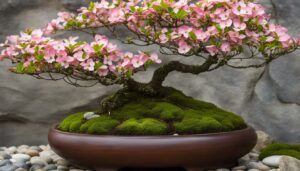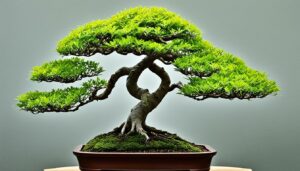Are you looking for a stunning addition to your bonsai collection? Look no further than the Crepe Myrtle Bonsai. This beautiful and vibrant deciduous bonsai is highly sought after by enthusiasts for its unique growth habits, stunning flowers, and delicate foliage. With proper care and cultivation, you can create a living masterpiece that will bring joy and beauty to your garden for years to come.
In this comprehensive guide, we will introduce you to the stunning world of Bonsai Tree Species Crepe Myrtle. You will learn about its characteristics, how to select the right bonsai for your collection, potting and repotting techniques, pruning and shaping methods, as well as watering and fertilizing tips. Additionally, you will gain insights into overwintering, pests and disease management, and display and presentation techniques that will showcase the natural beauty of your bonsai.
Whether you’re a seasoned bonsai enthusiast or a novice gardener, this guide will offer valuable insights into caring for your Crepe Myrtle Bonsai. Are you ready to discover the endless possibilities of this flowering bonsai? Let’s get started.
Key Takeaways:
- The Crepe Myrtle Bonsai is a stunning addition to any bonsai collection.
- With proper care and cultivation, you can create a living masterpiece that will bring joy and beauty to your garden for years to come.
- In this guide, you will learn about the characteristics of the Crepe Myrtle Bonsai, how to select the right bonsai for your collection, potting and repotting techniques, pruning and shaping methods, as well as watering and fertilizing tips.
- Additional insights into overwintering, pests and disease management, and display and presentation techniques that will showcase the natural beauty of your bonsai.
- Whether you’re a seasoned bonsai enthusiast or a novice gardener, this guide will offer valuable insights into caring for your Crepe Myrtle Bonsai.
Understanding the Crepe Myrtle Bonsai
When it comes to bonsai species, few are as unique and stunning as Bonsai Tree Species Crepe Myrtle, or Lagerstroemia bonsai. The Crepe Myrtle Bonsai is highly sought after by bonsai enthusiasts due to its delicate foliage, exquisite flowers, and unique growth habits. Here are some important characteristics of this species to keep in mind:
| Growth Habits | Foliage | Flowers |
|---|---|---|
| The Crepe Myrtle Bonsai is a deciduous tree that grows up to 30 feet tall in the wild. As a bonsai, it can grow up to two feet. | The delicate foliage of the Crepe Myrtle Bonsai is characterized by its oval, glossy leaves that grow in clusters on shoots. | The Crepe Myrtle Bonsai produces beautiful flowers that range in color from pink and lavender to red and white. These flowers bloom in mid-summer and continue into early fall. |
With its stunning appearance and unique characteristics, the Crepe Myrtle Bonsai is a truly breathtaking addition to any bonsai collection.
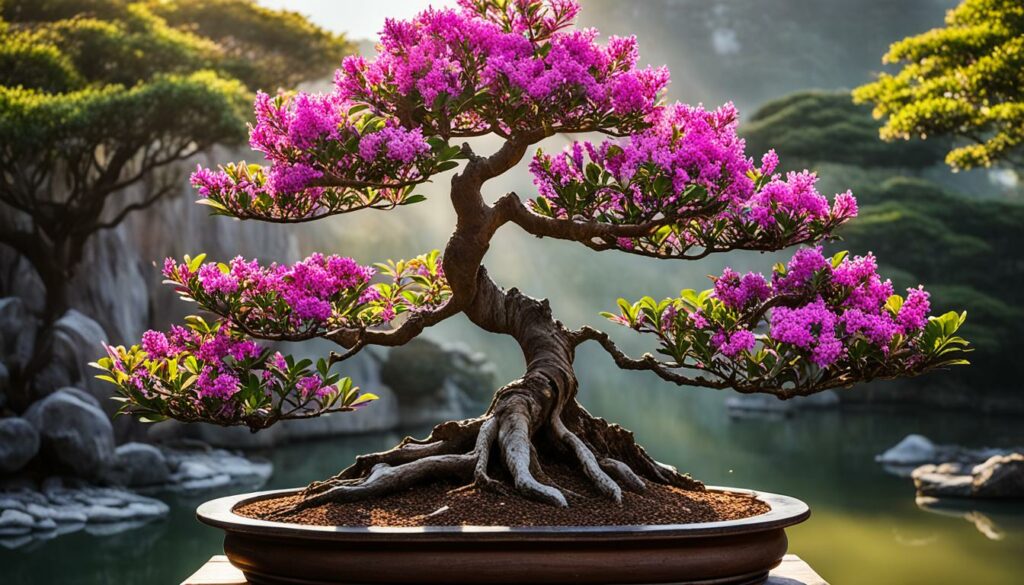
Selecting the Right Crepe Myrtle Bonsai
When selecting a Crepe Myrtle Bonsai, there are several key factors to consider. One of the most important is the variety of the tree, as each variety has unique characteristics and requirements.
In terms of characteristics, one of the most sought-after traits in Crepe Myrtle Bonsai is the ability to produce beautiful, vibrant blooms. If you are looking for a flowering bonsai, be sure to choose a variety that is known for its abundant blooms, such as the Lagerstroemia indica ‘Zuni’ or Lagerstroemia indica ‘Choctaw’.
Another factor to consider is your personal gardening goals. Some Crepe Myrtle Bonsai varieties are more suitable for specific bonsai styles, such as formal upright or slanting styles. Be sure to select a variety that aligns with your goals or preferences.
It is also important to consider the age and health of the bonsai tree. Younger trees are easier to shape and train, while older trees may have more character and be more visually striking. Additionally, be sure to inspect the tree for any signs of disease or damage before purchasing.
Crepe Myrtle Bonsai Varieties for Flowering
| Variety Name | Flower Color | Bloom Time |
|---|---|---|
| Lagerstroemia indica ‘Zuni’ | Pink | Summer to fall |
| Lagerstroemia indica ‘Choctaw’ | Purple | Summer to fall |
| Lagerstroemia indica ‘Sioux’ | Pink/Purple | Summer to fall |
| Lagerstroemia indica ‘Tonto’ | Red | Summer to fall |
| Lagerstroemia indica ‘Natchez’ | White | Summer to fall |
Keep these factors in mind when selecting a Crepe Myrtle Bonsai for your collection, and you will enjoy a beautiful and rewarding addition to your garden.
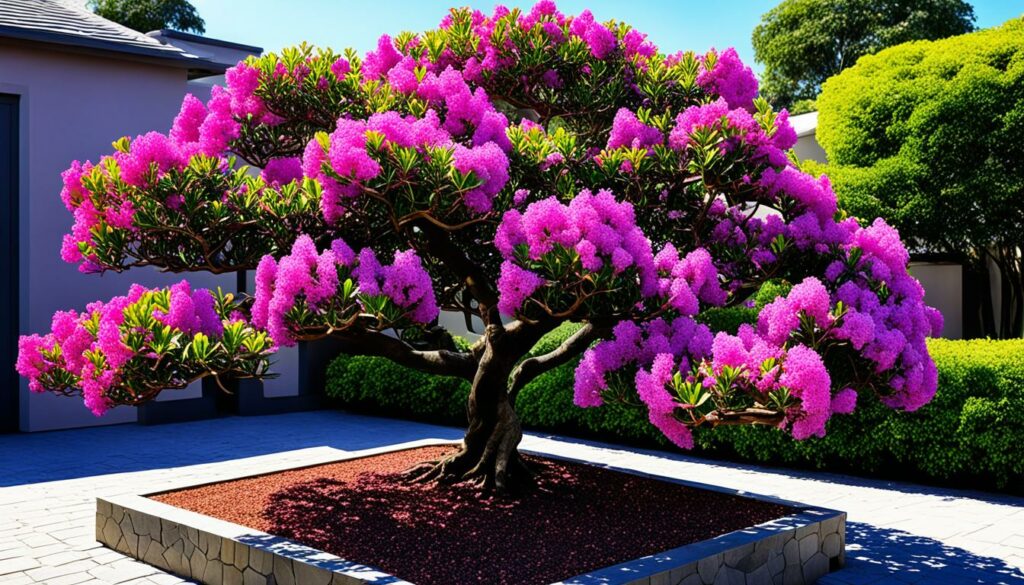
Potting and Repotting Techniques
Proper potting and repotting are essential for the healthy growth and development of your Crepe Myrtle Bonsai. In this section, we will offer expert tips and techniques to master the art of potting and repotting your bonsai.
When considering the potting medium, it is crucial to select a well-draining soil mixture that allows proper drainage while retaining the right amount of moisture. A soil mixture packed too tightly will hinder root growth and lead to a waterlogged bonsai. At the same time, inadequate moisture retention will cause the soil to dry out faster, starving the bonsai of the much-needed water.
| Potting | Repotting |
|---|---|
|
|
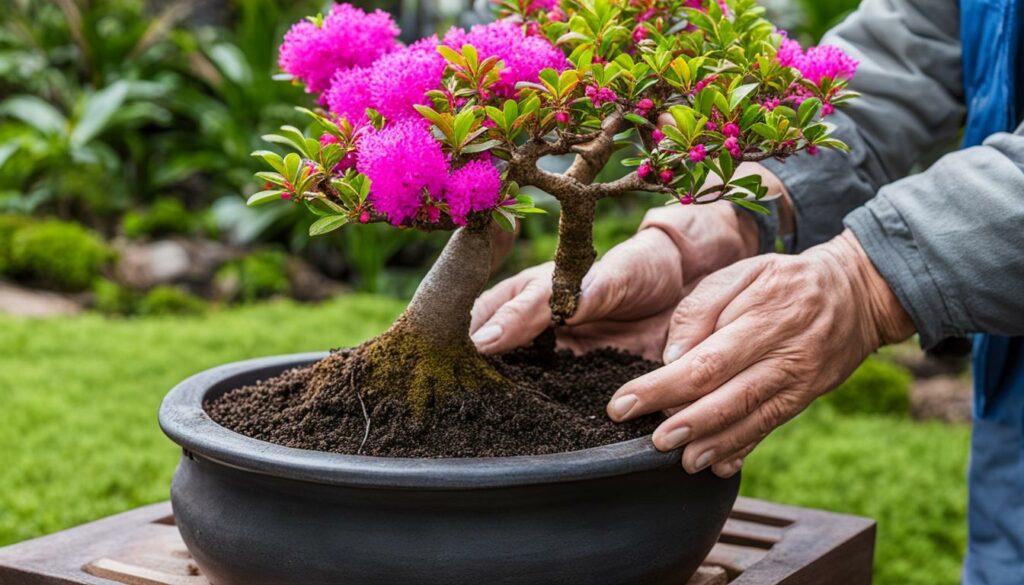
Remember to select a container that is proportional to the size of your Crepe Myrtle Bonsai. The pot should be shallow to allow proper root development while ensuring that water can penetrate through the soil and out of the drainage holes. After potting or repotting, avoid exposing your bonsai to direct sunlight, windy, or extreme temperatures. Keep it in a shaded area for a few days and gradually increase the exposure until it’s back in its usual location.
Pruning and Shaping Your Crepe Myrtle Bonsai
Proper pruning and shaping techniques are essential for maintaining the health and beauty of your Bonsai Tree Species Crepe Myrtle. Pruning helps to stimulate growth, prevent disease and insect infestation, improve airflow, and enhance the bonsai’s natural shape. In this section, you will learn the essential pruning methods and shaping techniques for your deciduous bonsai.
First, determine the main branches of your Crepe Myrtle bonsai and focus your pruning efforts on smaller branches that originate from the main ones. Use sharp, clean shears or scissors to make a clean cut at a 45-degree angle. Avoid leaving any rough edges or open wounds, as this can invite disease and decay.
When shaping your Crepe Myrtle bonsai, keep in mind the overall design style you want to achieve. Some popular styles include formal upright, informal upright, slanting, and cascade. Cut back branches that are growing too long or in the wrong direction and wire the remaining branches to shape them according to your desired style. Be sure to check your wires regularly and adjust them as needed.
When you first start pruning and shaping your Crepe Myrtle bonsai, be patient and take it slowly. Avoid making drastic cuts or shaping changes all at once. Instead, make small tweaks over time, and allow your bonsai to adjust and develop its natural shape and character.
Watering and Fertilizing
Proper watering and fertilizing are essential for the health and vitality of your Crepe Myrtle Bonsai. These steps will help your tree grow and thrive.
Watering
Crepe Myrtle Bonsai needs regular watering to keep the soil moist but not saturated. The frequency of watering depends on various factors such as humidity, temperature, the size of your pot, and the time of year. During the hot summer months, you may need to water your bonsai daily. Use a watering can or a hose with a fine spray attachment to gently moisten the soil. Make sure the water reaches the roots but avoid pouring it on the foliage, as it can cause damage.
To check if your bonsai needs watering, insert a chopstick into the soil. If it comes out dry, it’s time to water. If it’s moist, wait a day or two before checking again. Overwatering can lead to root rot and other health problems, so be cautious.
Fertilizing
Fertilizing is crucial to provide your Crepe Myrtle Bonsai with the nutrients it needs for healthy growth and abundant blooms. Use a balanced, organic fertilizer or a specialized bonsai fertilizer according to the instructions on the label. Generally, fertilize in early spring and midsummer, but avoid fertilizing in the winter months.
Apply the fertilizer evenly across the soil surface, avoiding the trunk and leaves. Water your bonsai immediately after fertilizing to help the nutrients soak into the soil. Regular fertilizing will promote a luscious foliage and vibrant flowers.
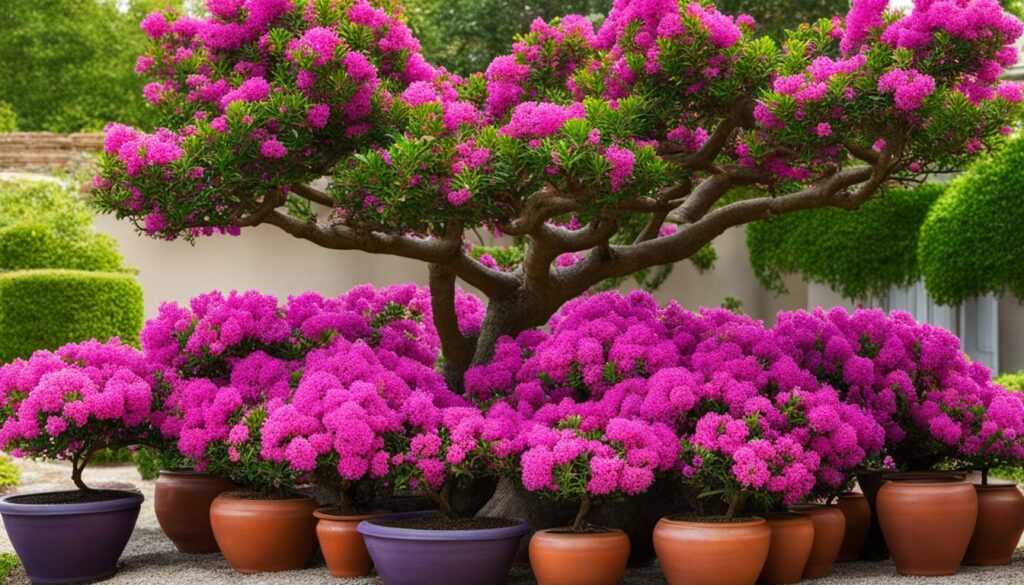
Remember, proper watering and fertilizing are the keys to a healthy and beautiful Crepe Myrtle Bonsai.
Overwintering Tips
As winter approaches, it’s important to prepare your Crepe Myrtle Bonsai for the colder months. While this deciduous bonsai is hardy and able to withstand cold temperatures, it still requires proper care to ensure its survival and vitality.
Timing is Everything
The first step in overwintering your Crepe Myrtle Bonsai is to take note of the climate in your area. As a deciduous tree, the Crepe Myrtle requires a dormant period during the winter months. When the leaves begin to fall, it’s time to start preparing your bonsai for the colder temperatures.
Keep it Cozy
One of the most important aspects of overwintering your Crepe Myrtle Bonsai is protecting it from freezing temperatures. You may want to consider moving it indoors, to a cool, bright location with good air circulation, such as a garage or shed. It’s important to keep the bonsai away from any heaters or sources of direct heat that could cause harm to the tree.
Watering and Fertilizing
Remember to adjust your watering schedule during the winter months. Overwatering can cause root rot, which can be fatal to your bonsai. Check the soil regularly and only water when the soil feels dry to the touch. You should also hold off on fertilizing your Crepe Myrtle Bonsai during the winter months, as it will not be actively growing.
Cover Up
If you choose to keep your Crepe Myrtle Bonsai outdoors during the winter months, be sure to cover it with a protective layer to prevent freezing temperatures from damaging the tree. You can use burlap or frost cloth to wrap the tree, making sure not to wrap it too tightly, which can cause damage.
Monitor and Protect
During the winter months, it’s important to keep an eye on your Crepe Myrtle Bonsai, checking for any signs of damage or disease. Prune away any damaged or diseased branches, and protect the tree from harsh winds and frost. By monitoring and protecting your Crepe Myrtle Bonsai, you can help ensure its survival and vitality for years to come.
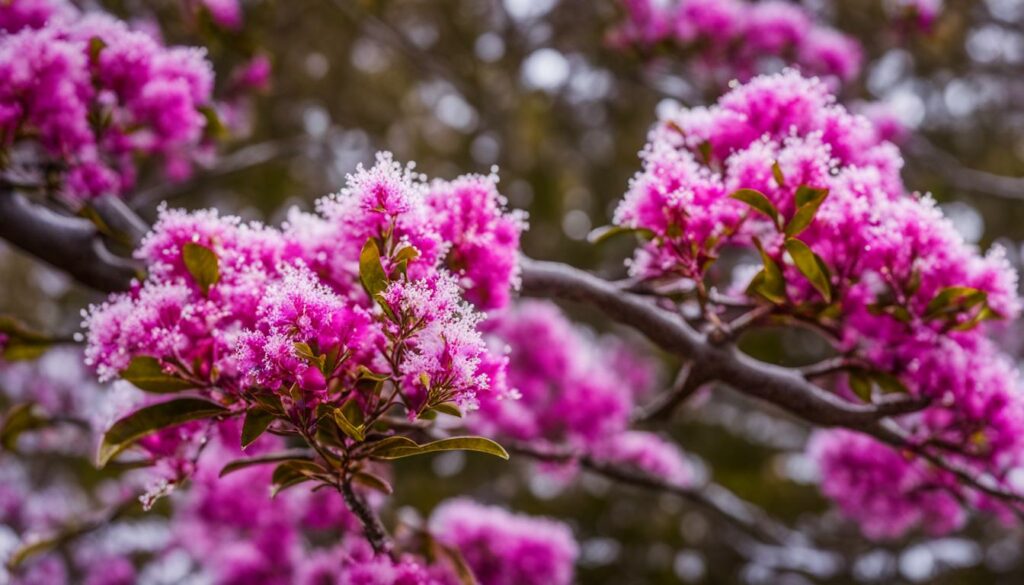
Pests and Diseases Management
Although Crepe Myrtle Bonsai trees are generally hardy, they are still susceptible to a range of pests and diseases that can damage their health. Here are some of the most common problems and their solutions.
Prevention
The best way to avoid pest and disease problems is to maintain your bonsai’s health through proper care. Make sure to provide adequate water, light, and nutrients, and avoid over-fertilizing or using harsh chemicals. Keep an eye out for any signs of stress or damage, and address them promptly.
Identification
When it comes to pests and diseases, early detection is essential for effective treatment. Regularly inspect your bonsai for any signs of damage, discoloration, or unusual growth. Look for pests such as spider mites, aphids, and scale insects, as well as diseases like powdery mildew, leaf spot, and bacterial blight.
Treatment
If you do notice any signs of pest or disease problems, act quickly to prevent further damage. Treatment options may include organic or chemical insecticides, fungicides, or other products specifically designed for bonsai care. However, always follow the manufacturer’s instructions carefully and use caution when applying any chemicals to your bonsai.
Tip: Always quarantine any new bonsai trees that you bring into your collection to prevent the spread of pests or diseases to your existing trees.
Common Pests and Diseases
| Pest/Disease | Symptoms | Treatment |
|---|---|---|
| Spider Mites | Small yellow or red speckles on leaves. Fine webbing on the plant. | Apply insecticidal soap or neem oil. Increase humidity around the plant |
| Aphids | Tiny, pear-shaped insects that can be green, yellow, black, or brown. Sticky residue on leaves and stems. | Use insecticidal soap or neem oil. Encourage natural predators like ladybugs or lacewings |
| Powdery Mildew | White, powdery coating on leaves and flowers. | Provide good air circulation and reduce humidity around the plant. Apply fungicides such as copper or sulfur spray. |
| Leaf Spot | Brown or black spots on leaves. Can lead to defoliation if left untreated. | Remove infected leaves and dispose of them. Treat with a fungicide spray like copper or sulfur. |
| Bacterial Blight | Yellow or brown spots on leaves, with dark borders. Can cause dieback of twigs and branches. | Remove infected branches or twigs. Treat with a copper-based fungicide spray. |
By following these strategies for pest and disease management, you can keep your Crepe Myrtle Bonsai healthy and thriving for years to come.
Display and Presentation
Creating an eye-catching display can showcase the natural beauty of your Crepe Myrtle Bonsai. Whether you are showcasing a single tree or a collection, there are countless ways to display your bonsai for maximum impact.
A popular method is using stands to elevate the tree and accentuate its form. Consider using a contrasting color or texture to complement the bark and foliage of your Bonsai Tree Species Crepe Myrtle.
Another way to add interest is with unique containers or pots, like those made of ceramics or natural materials. Avoid using overly ornate pots as they can distract from the tree’s natural beauty.
If your Crepe Myrtle Bonsai has a striking flower display, you may want to position it in a central location, such as on a table or shelf, where it can be appreciated from all angles.
For an added touch of elegance, incorporate surrounding elements like rocks, sand, or gravel to create a more dramatic tableau.
Display Tips
| Display Tips | Description |
|---|---|
| Use stands or risers | Elevates tree and accents form |
| Incorporate unique containers or pots | Ceramic or natural materials can add interest |
| Position in central location | Such as on table or shelf |
| Add surrounding elements | Like rocks, sand, or gravel for dramatic effect |
Troubleshooting Common Issues
Even with proper care, your Crepe Myrtle Bonsai may encounter issues that can threaten its growth and health. Here are some common problems you may face:
| Issue | Possible Causes | Solutions |
|---|---|---|
| Yellowing leaves | Overwatering, nutrient deficiency | Adjust watering schedule and add appropriate fertilizer |
| Dry, wilting leaves | Underwatering, spider mites | Ensure proper watering and treat pests with appropriate solution |
| Poor drainage | Root-bound, improper soil mixture | Repot with appropriate soil mixture, prune roots if necessary |
| No blooms | Insufficient sunlight, improper pruning | Ensure adequate sunlight, prune branches to encourage vertical growth |
If your Crepe Myrtle Bonsai is showing signs of distress, it is crucial to identify and address the underlying issue promptly. Consult with a professional if necessary to ensure the ongoing health and vitality of your tree.
Conclusion
Now that you have discovered the stunning world of Crepe Myrtle Bonsai, it’s time to get your hands dirty and start cultivating your own living masterpiece. Remember that the Lagerstroemia bonsai is a flowering, deciduous bonsai that requires specific care and attention to thrive.
By understanding the unique characteristics of this bonsai tree species, you can select the right Crepe Myrtle Bonsai that suits your personal preferences and gardening goals. Don’t forget to master the art of potting and repotting, pruning and shaping, and watering and fertilizing.
As you care for your Crepe Myrtle Bonsai, keep an eye out for common pests and diseases, and use effective strategies for prevention and treatment. And when it comes to display and presentation, let your creativity run wild as you showcase the natural beauty of your bonsai for maximum impact.
With patience and dedication, you can watch your Crepe Myrtle Bonsai grow and flourish before your eyes, bringing vibrant colors, delicate foliage, and enduring beauty to your garden. So why wait? Start your journey into the world of Crepe Myrtle Bonsai today!
FAQ
What is a Crepe Myrtle Bonsai?
A Crepe Myrtle Bonsai is a miniature version of the Lagerstroemia bonsai tree, which is known for its stunning flowers and attractive foliage. It is a deciduous bonsai species that adds a colorful touch to any garden.
How do I care for a Crepe Myrtle Bonsai?
To care for a Crepe Myrtle Bonsai, you should provide it with appropriate sunlight, water it regularly but avoid overwatering, use well-draining soil, and fertilize it during the growing season. Pruning and shaping are also important for its maintenance.
Can Crepe Myrtle Bonsai trees survive winter?
Yes, Crepe Myrtle Bonsai trees can survive winter. However, they are deciduous and may lose their leaves during this season. It is important to protect them from freezing temperatures and provide adequate care to ensure their survival and vitality.
How often should I water my Crepe Myrtle Bonsai?
The watering frequency for a Crepe Myrtle Bonsai depends on various factors such as climate, season, and soil moisture levels. As a general guideline, you should water it thoroughly when the top inch of soil feels dry, ensuring that water drains out of the pot’s drainage holes.
What type of soil is best for a Crepe Myrtle Bonsai?
A well-draining soil mixture is best for a Crepe Myrtle Bonsai. It should consist of components such as bonsai soil, perlite, and compost to ensure adequate drainage and proper root development.
How do I prune and shape my Crepe Myrtle Bonsai?
Pruning and shaping a Crepe Myrtle Bonsai involve removing unwanted branches, shaping the tree into the desired form, and promoting its overall health and aesthetics. It is essential to use sharp and clean tools and follow proper techniques to avoid damaging the tree.
What are the common pests and diseases that affect Crepe Myrtle Bonsai?
Crepe Myrtle Bonsai trees are susceptible to pests such as aphids, scale insects, and spider mites. They can also be prone to diseases like powdery mildew and sooty mold. Regular inspection and appropriate measures can help manage these issues.
How should I display my Crepe Myrtle Bonsai?
When displaying your Crepe Myrtle Bonsai, consider factors such as the bonsai style, the presence of colorful flowers or foliage, and the overall aesthetics. You can use bonsai display stands, accent plants, and appropriate containers to enhance its presentation.
What should I do if my Crepe Myrtle Bonsai has problems?
If your Crepe Myrtle Bonsai faces any issues such as yellowing leaves, pests, or diseases, take prompt action. Identify the problem, consult knowledgeable sources, and implement appropriate remedies or seek professional help to ensure the health and well-being of your bonsai.
